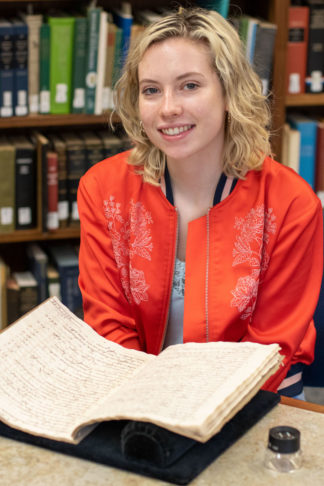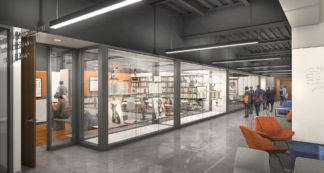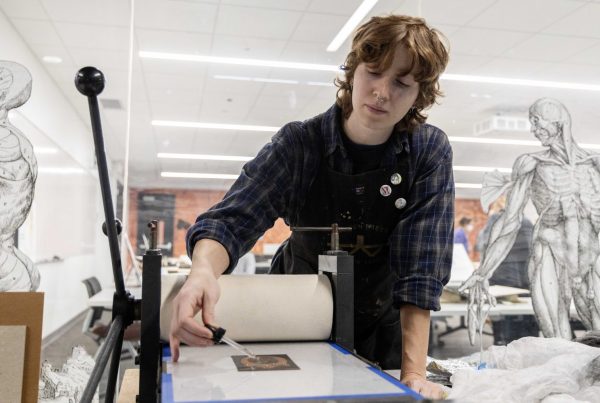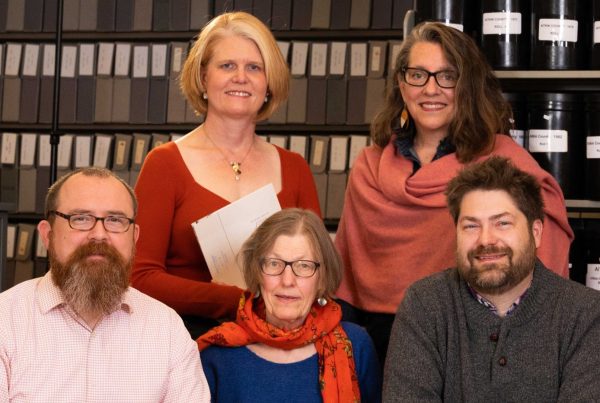By Emily Reimer

Louisa Botten. Photo credit Allison Thompson.
In the Wangensteen Historical Library of Biology and Medicine (WHL), hands-on opportunities to use historical texts can go hand-in-hand with learning modern technology, like GIS software.
Louisa Botten, a first year undergraduate at the University of Minnesota, did both as part of her CLA Dean’s First Year Research & Creative Scholars Program internship in WHL.
Over the course of her internship, Botten researched a 17th-century apothecary inventory from Toulouse, France, learning to decipher and translate the unique handwriting of a scribe writing in French in 1645. She then used ArcGIS to map the global distribution of the origins of pharmaceutical products listed in the inventory.
Her internship culminated in the creation of the online exhibit Journeying through a 17th-century apothecary manuscript, which won a 2019 Best Maps prize from U-Spatial, the center on campus for GIS and spatial research.
Recently Botten shared a bit of her experience of developing her research project.
Q: What new skills did you learn while you worked at WHL?
LB: With the help of Lois Hendrickson [Curator] and Emily Beck [Assistant Curator], I transcribed and translated a 17th-century manuscript from an apothecary. When I first started the research project, I could not even read the writing in the manuscript, so they worked with me to learn to read the scribe’s writing. From there, I researched each ingredient (or as many of them as I could find) and learned about their uses and possible sources where the apothecary could have obtained the medical ingredients.
Then I mapped all the ingredients on a historical map and documented what I learned from my research and the mapping. Through this experience, I learned mapping skills, translating and transcribing skills. Lois and Emily also helped me shape the format of my project and taught me to write for a public audience online.
Q: You worked closely with WHL curators and staff to develop your research project. What was that like?
LB: When I first met with Emily and Lois, we discussed my interests and the skills I had coming into the research experience. It worked out perfectly that I had a background in French, and WHL had recently acquired the apothecary manuscript. As I went through the transcribing and translating process, which ultimately resulted in a list of medical ingredients, Emily and Lois thought a map would be the perfect format for displaying the information I had learned.
Q: How has your experience positioned you for the future?
LB: While these skills may seem very specific, they can all be generalized and applied to my entire academic career. As I was new to many of these tasks, transcribing, translating, mapping and writing for a public audience, I had to ask for help.
I learned to ask various groups at the University, my faculty advisors, Lois and Emily, and other people working at the library, like Christopher Herzberg [Library Assistant and Preservation Specialist]. Being presented with a manuscript that was essentially just a list of medical ingredients, I also learned how to make a project out of information that had very little structure. The U-Spatial help office provided me with a lot of support in regards to all of my mapping questions, as I knew nothing about mapping before starting this project. With guidance, this information fit perfectly into a map and could be actually understood by an audience.
This was a great experience overall and I was able to put it towards my Honor’s requirements and on my resume.
Q: What would you say to others about why it is important to connect with the University of Minnesota Libraries?
LB: I would say that there is always so much more to be learned about research, a process everyone at the CLA has to embark on at some point. Librarians can not only help you find resources but can also help you shape and refine your project.
Don’t forget to check out Louisa’s Story Map, Journeying through a 17th-century apothecary manuscript!
The manuscript Louisa worked with is part of the Wangensteen’s collections and is available to researchers. The Wangensteen Library is open Monday – Friday from 8:00 a.m. to 4:30 p.m.
We’re on the move!

A rendering of the new Wangensteen space in the Health Sciences Education Center
In 2020, the Wangensteen Historical Library will be moving into the newly-constructed Health Sciences Education Center, supporting student success stories like Louisa Botten’s.
Learn more about our move and how you can help build skills to build bright futures, supporting learners at all levels as they apply knowledge from primary source material to gain essential skills in research, writing, and critical thinking.




